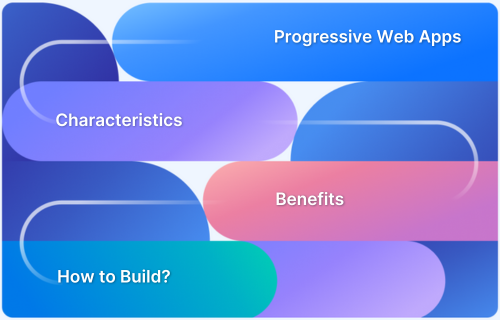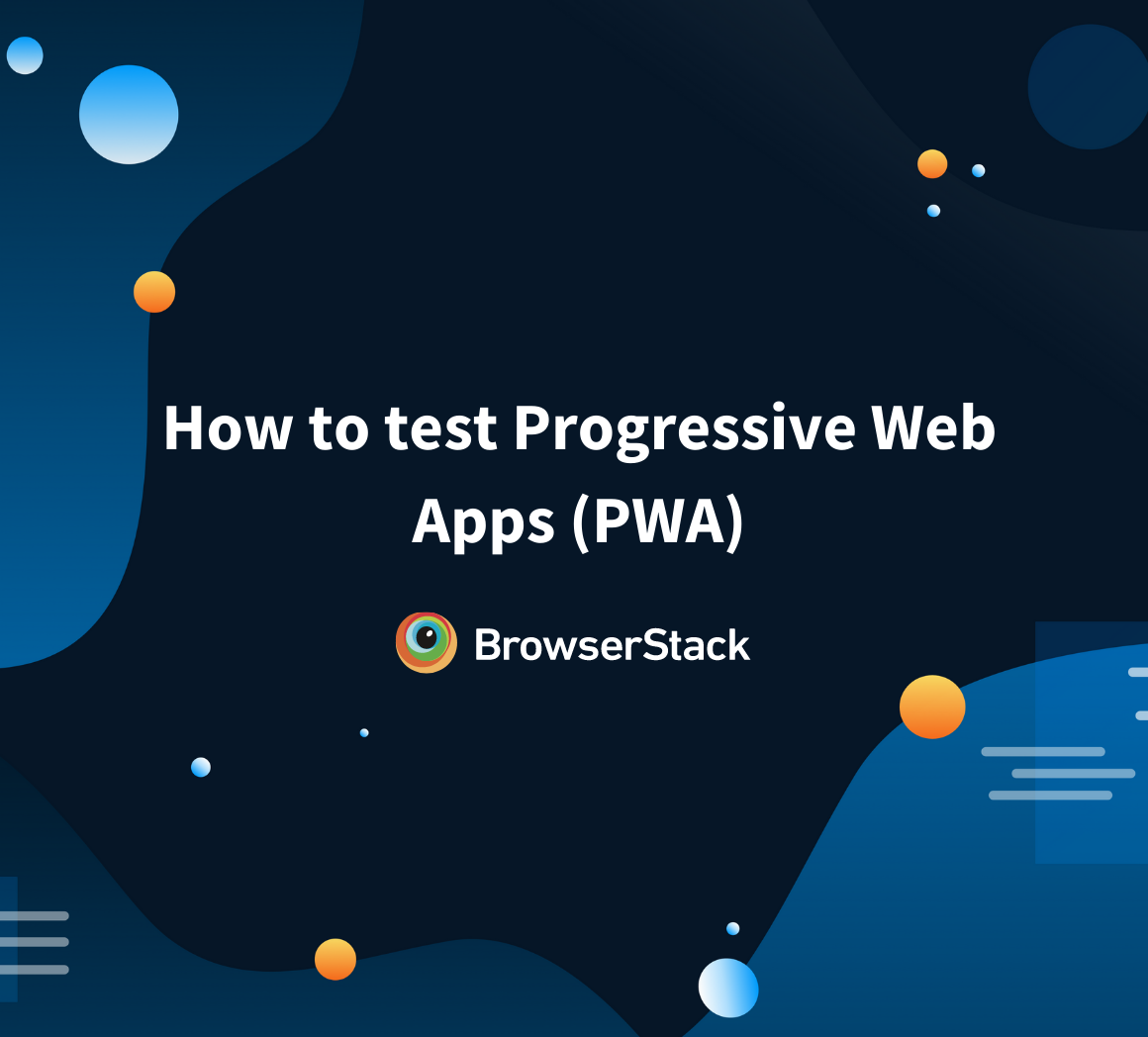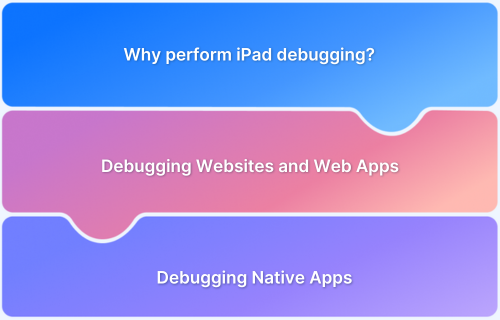Progressive Web Apps (PWAs) have emerged as a powerful solution for delivering fast, reliable, and engaging user experiences across devices. By combining the best features of web and mobile applications, PWAs offer the ability to work offline, provide push notifications, and function seamlessly across browsers.
Overview
A PWA framework streamlines the development of Progressive Web Apps by providing tools and libraries that simplify key features like service worker integration, offline support, and push notifications. To choose the right PWA framework, consider the below-mentioned factors:
- Performance
- Size of the
- Adaptability to Third-party Tools
- Development Time
- Support
- Scalability
- Maintenance
Best PWA testing tools:
- BrowserStack
- Lighthouse
- PWABuilder
- TestCafe
- Applitools
Choosing the right PWA framework is crucial for maximizing the potential of these apps. This article guides you on how to choose a PWA framework.
What are Progressive Web Apps (PWA)?
Progressive Web Apps are applications that run on browsers built using conventional website development technologies but also combine the features of a native application. It combines all the standout features of a web application and the native application without the complexities of having a native app.
Some well-known brands aligned with the PWA framework are Uber, Twitter, Spotify, and Pinterest, among others.
Features of Progressive Web Apps (PWA)
Progressive Web App comes with a blend of the best features of mobile and web applications. Here are the key features of PWA that make it stand out as a popular choice:
- Responsive: It can adapt to any device or screen size.
- Offline Mode: It can work without an internet connection via cached data.
- Installable: You can add it to the home screen without needing any app store.
- Push Notifications: Shares real-time updates with users.
- Remains Updated: It automatically fetches the latest updates.
Benefits of Progressive Web Apps
Here are some benefits of the PWAs:
- Best of Both Worlds: Combines the best features of native and web applications.
- No Storage Issues: No storage space required on your device.
- Universal Compatibility: Cross-browser compatible and works across all devices.
- Familiar Technologies: Built with conventional technologies like JavaScript, HTML, and CSS.
- Developer-Friendly: No need to learn additional programming languages for each platform.
- Seamless Updates: Automatically update in the background without manual intervention.
Limitations of Progressive Web Apps (PWA)
Here are a few limitations of Progressive Web Apps:
- Limited Device Features: PWAs may not have access to all device features, such as Bluetooth or advanced camera functionalities, compared to native apps.
- Performance on Low-End Devices: PWAs may not perform as well on lower-end devices with limited resources.
- Browser Compatibility: Some older browsers or less common browsers may not fully support PWA features.
- Limited App Store Presence: PWAs are not listed on app stores, which can reduce visibility and discovery compared to native apps.
What is Progressive Web App Framework
A Progressive Web App Framework is a development toolkit to help simplify the development of PWAs. This framework consists of tools, libraries, and best practices for developers to build progressive web apps efficiently.
Functions of PWA Frameworks
Here are the key functions of PWA frameworks:
- Offline Functionality: It simplifies service worker integration by managing offline capabilities, caching, and background tasks.
- Push Notifications: Automates push notification setup for real-time user engagement.
- Secure Connections: Ensures secure HTTPS connections by default, safeguarding user data.
- Web App Manifest: Automates the creation and management of the Web App Manifest for app-like behavior.
- Cross-Device Compatibility: Builds apps that function seamlessly across multiple devices and browsers.
Importance of a PWA Framework
Here’s why you should use a PWA framework:
- Simplified Development: With pre-built tools, you can simplify the development process and manage complex PWA features.
- Key PWA Integration: With this framework, you can integrate important PWA features like service workers and HTTPS.
- Cross-Platform Compatibility: A single code base can work on all types of devices and browsers.
- Scalability: Supports both small and large-scale applications seamlessly.
How to choose a PWA framework?
Choosing a PWA framework to develop a high-quality application and enjoy the full benefits of a Progressive Web application is imperative. The following factors must be considered when choosing a Progressive Web App Framework.
1. Performance
One of the critical factors in selecting a PWA framework is to evaluate which application delivers a high-performing app. Server-side rendering is an essential component in determining the effectiveness of the application. If the PWA framework is bulky, the app will take a long time to load.
2. Size of the App to be developed
Depending on the application’s size, you must choose the development framework. An extensive framework or library with many components is required if the app is large. For smaller applications with minimal features, the PWA framework can be light-in-weight.
3. Adaptability to Third-party Tools
Frameworks used for PWA development are still in the process of perfection. There are times you need to use third-party tools for certain services. The chosen framework should be compatible with external libraries or tools.
4. Development Time
Some PWA frameworks require you to learn a new programming language. It works if your team has the bandwidth to learn the language. If not, you may have to find a language that is easy to learn and uses conventional programming language familiar to many.
5. Support
Well-documented Progressive Web App Frameworks will be an excellent support for the developers. Also, online support communities are beneficial and prompt in responding to or resolving issues. It is prudent to choose a framework depending on the support offered.
6. Scalability
The framework should handle seamless feature updates and the introduction of new features. As the scale of the App grows, the PWA frameworks should make your life easier. The frameworks should support integration with third-party tools and increasing application size.
7. Maintenance
Maintenance of code is vital for every project. The PWA framework should be able to make code maintenance easy. Frameworks should support the development of reusable components. Any newcomer to the project team should be able to start working on the code with minimum training. Grouping and maintenance of code should be fine for the developer.
Follow-Up Read: Why is Maintainability Testing important?
Top 5 Progressive Web App (PWA) Frameworks
Here are 5 best Progressive Web App (PWA) frameworks to use:
1. Angular
Angular is a framework that comes with built-in PWA support through Angular CLI. This framework integrates seamlessly with service workers for offline capabilities. Angular is best suited for scalable web apps.
2. React
React is a flexible framework for progressive web apps that can be paired with libraries like Workbox to drive PWA features. It is best suited for dynamic and interactive apps.
3. Vue.js
Vue.js is a lightweight framework with an easy learning curve. It provides plugins like @vue/pwa that help add PWA capabilities.
Read More: Browser Compatibility for VueJS Web Apps
4. Ionic with Capacitor
Ionic with Capacitor is an open-source framework that supports the creation of Progressive Web Apps. Capacitor, Ionic’s native runtime, helps create hybrid apps like PWAs with a single codebase for iOS, Android, and the web.
5. Svelte
Svelte is a simple yet fast and reactive framework. It efficiently compiles highly optimized vanilla JavaScript for PWAs. This lightweight framework is best suited for building high-speed PWAs with reduced overhead.
Angular vs React vs Vue: How to choose the best PWA Framework?
Angular, React, and Vue are the most popular PWA frameworks. However, the question is which framework is best for your needs.
Angular is a comprehensive framework for developing large scale apps. It comes with in-built features like routing and state management.
React, on the other hand, is a flexible library that focuses on dynamic UIs, and needs additional libraries for PWA features. Vue is a lightweight, intuitive framework for small to medium-sized apps.
The table below outlines the main differences between Angular vs React vs Vue:
| Angular | React | Vue |
|---|---|---|
| Angular has a unique feature of converting Angular HTML and TypeScript code to JavaScript code before the browser downloads and runs the PWA App. It is called the ‘Ahead of Time compilation’ method. | React is a Javascript library that is very lightweight. It aids in fast development. The ‘Create a new React App’ generator is a unique feature that aids in the easy development of PWA apps. | Vue is a Model View View Model (MVVM) JavaScript framework. The best quality of Vue is that it takes the best parts of Angular and React and improves existing web technologies like HTML and CSS. |
| It is a full-fledged framework with complex infrastructure and a lot of elements. Suitable for larger projects. | It is more of a library and easily compatible with other frameworks. Development flexibility is more. | It is based on HTML and CSS and can easily integrate with TypeScript and JSX. So development is easy with a large section of developers already familiar with HTML and CSS. |
| There is no need for third-party app support as everything is included in this framework. | The apps created using React are more scalable and flexible as there is good support for integrating third-party tools. | It is the most flexible of all three in terms of scalability. |
| Angular has a huge Support Community but it is not as big as React’s. | React has the biggest support community. The code is maintained effectively, making the developer’s operations smooth. | It has a relatively small community, and resolving issues takes time. |
| Has the backing of Google | Has the backing of Facebook | A single entity owns it. |
| It is well documented. | Poor documentation. | Poor documentation. |
| It is bulky and uses client-side rendering. | It is very lightweight, and its performance is excellent. | It is very lightweight and uses a Virtual DOM like React. |
| The performance is slow compared to React and Vue, but it is noticeable only when delivering a small application. | Server-side UI rendition is fast as it uses a Virtual DOM. | Server-side rendition aids in its performance. |
| It is SEO friendly when used along with Angular Universal. | It is SEO friendly when used along with Next.js. | It is SEO friendly when used along with Nuxt.js. |
| The framework is complex, and the developer takes time to learn it. The developer also needs to know TypeScript. | It is a library and easy to implement. JSX programming is to be discovered. | It uses HTML and CSS as a base.There is a large community of developers familiar with these technologies. So it is easy to learn and adapt. |
Best Tools for Testing Progressive Web Apps (PWAs)
Ensuring your PWA delivers a reliable and seamless experience across devices requires robust testing. Below are four essential tools to help you validate functionality, performance, and compliance:
1. BrowserStack
A cloud-based testing platform that lets you test PWAs on real devices and browsers without setting up a device lab. It supports responsive testing, geolocation testing, and service worker validation to ensure your PWA works across multiple environments.
Use it for:
- Device and Browser compatibility
- Network throttling and geolocation testing
- Real device service worker testing
- UI and Accessibility Testing
2. PWABuilder
A developer tool from Microsoft that helps you convert a website into a PWA. It evaluates your app’s manifest, service worker, and overall readiness, and also offers packaging for various platforms like Windows and Android.
Use it for:
- Manifest and service worker validation
- Generating service worker templates
- Packaging PWAs for app stores
3. TestCafe
A JavaScript-based end-to-end testing framework that works in all modern browsers. It automates user interactions and validates that your PWA functions correctly under real-world conditions.
Use it for:
- UI automation and functional testing
- Testing service worker behavior
- Validating offline mode and caching logic
Conclusion
The frameworks used may differ from project to project depending on the requirements and the type of Progressive Web App. For effective testing of PWA across browsers and various platforms, BrowserStack’s cross-browser testing is the one-stop solution for all your testing needs, with over 3500+ real devices and browsers to test your native, hybrid, and PWA applications.
Needless to say, PWAs need to be tested on real mobile devices to verify functionality across devices. Different device architectures will cause a PWA to function differently, which is why real device testing is a mandate.
Frequently Asked Questions
1. Which technology is best for PWA?
The best technology for PWA will depend on the requirements of your project. You can go for React for dynamic, high-performance apps. Choose Angular for large-scale applications and if your app is more simple and lightweight, you can consider Vue. The choice is primarily dependent on the complexity, and scale.
2. What is a real-life example of PWA?
Twitter Lite is a real-life example of a Progressive Web App (PWA). It provides an app-like experience on mobile devices with minimal data usage and allows you to access features like offline access, push notifications.






